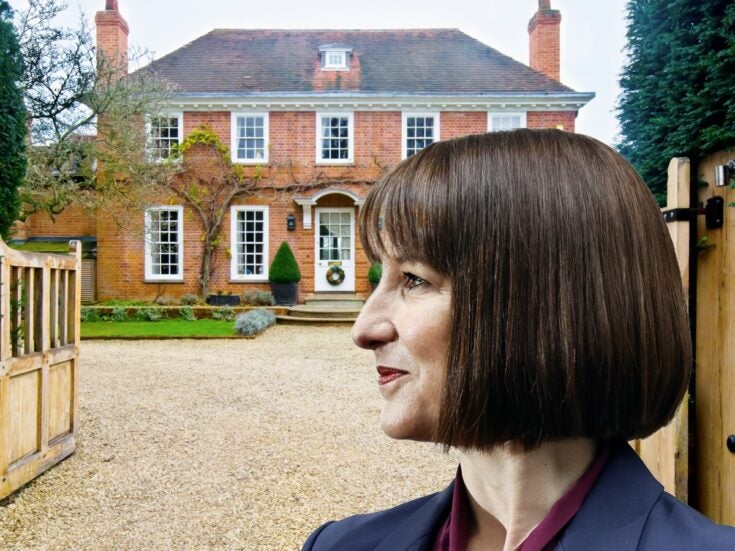
A family that can trace its lineage to Henry VIII’s third wife Jane Seymour, is embroiled in a bitter court battle over the future of their £85 million ancestral estate.
William Seymour, the Earl of Yarmouth, has accused his parents, the Marquess and Marchioness of Hertford, of unfairly withholding the 17th-century ancestral home Ragley Hall in Warwickshire from him.
The estate, which encompasses extensive farmland, woodlands and several properties, has been in the family for generations and the 32-year-old earl was expecting it to be handed down to him as the eldest son on his 30th birthday.
Now the earl and his wife are locked in a court hearing with his parents, who he claims have harboured resentment towards him since he married Kelsey Wells, a former Goldman Sachs banker. His father, Harry Seymour, told the High Court this week that relations between him and his son deteriorated ‘very sharply’ before his marriage to Wells and suggested the earl’s behaviour became increasingly confrontational.
The court heard William Seymour sent ‘hostile and inflammatory’ emails to his mother, Beatriz, in which he questioned his father’s ‘mental capacity’. The marquess and marchioness said the contents of these letters caused them ‘enormous upset and anger’.
The earl and his wife have also clashed with estate trustees over claims that they refused to release funds for their children’s private school fees. Further fuelling tensions, the couple alleges they were evicted from their cottage on the 6,000-acre estate with only a few days’ notice.
[See also: Can an educational trust help families pay off higher private school fees?]
The earl’s three siblings, Lady Gabriella Seymour, 32, Lord Edward Seymour, 30, and Lady Antonia Seymour, have taken their parents’ side in the dispute.
Trust issues
The earl and his wife, who run an elderflower liqueur distillery on the estate, are challenging the structure of the family trusts, seeking to replace the trustees, who they accuse of aligning with his parents. Their legal team argues that the trustees have ‘misdirected the estate’.
[See also: The best contentious trust lawyers in 2024]
However, lawyers representing his parents and three siblings argue that the earl’s conduct has been ‘unreasonable and vindictive’ and that the trustees — Ragley Trust Company and Seymour Trust Company—have acted fairly. Richard Dew, representing the marquess and marchioness, told the court the earl had already been granted more than £4 million in estate land and property by the time he turned 21.
Tim Sherwin – barrister for the two family trusts – claimed William had begun the conflict by raising the topic of his succession with his father.
[See also: Why female heirs still miss out in succession planning]
A lesson in trusts
The case highlights broader issues surrounding the governance of family trusts.
Paula Myers, national head of the Will, Trust and Estate Disputes team at Irwin Mitchell’s private client services practice, told Spear’s that these cases are ‘more common than ever’.

Myers says that trustees have a legal duty to balance the interests of all beneficiaries while upholding the intentions of the original settlor.
However, disputes often arise when beneficiaries feel sidelined or when trustees are perceived as exerting excessive control. While trustees must protect and manage assets responsibly, they can face legal challenges if they are seen as acting in self-interest, failing to invest funds properly, or disregarding their fiduciary duties.
[See also: Succession planning in an era of ‘increasing transparency’]
‘Trustees have a duty to look after the interests of all of the beneficiaries and strike a balance between their interests whilst taking into account what the original settlor (person who set up the trust) wanted,’ Myers says.
She adds: ‘We have handled cases where trustees have taken the view incorrectly, that the trust fund is effectively their money and they can spend it how they like, there are cases where trustees do nothing and don’t look to invest a trust fund or take specialist advice and how to invest, spend and protect the monies.’
James Lister, private wealth disputes partner at law firm Stevens & Bolton tells Spear’s trustees ‘owe a suite of onerous duties to their beneficiaries, which those beneficiaries have a direct right to enforce against [them].’ By the court if necessary, he adds.
‘This might be a failure by the trustees to account to the beneficiaries for their dealings with the trust assets, a failure to take into account the beneficiaries’ interests or a perceived view of bias against a beneficiary in the decisions the trustees make,’ he explains.
Does William Seymour have a legitimate grievance?
‘Legitimate is the key word here – a sense of entitlement or disappointment is not likely to be a legitimate grievance unless there are sound factual foundations for that concern,’ says Lister.
‘Ultimately, trustees do have myriad duties and are subject to the supervisory jurisdiction of the court – put another way, the court is always allowed to be asked to mark the trustees’ homework. So, if beneficiaries don’t feel that their grievances are being properly addressed, they can ask the court to intervene.’
How to avoid a family court succession drama
Myers says her team’s first suggestion would always be to try and talk about the issues with the parties involved, including the trustees and the beneficiaries.
‘Often parties are misunderstood or there can be a misunderstanding about what someone says or do’ she says.
‘If that does not work and talking or meetings is exhausted then beneficiaries can look to the court system to bring a breach of trust claim if there is a loss to the trust and to removal if the breach is so severe or where it is evident that the relationship has irretrievably broken down.
[See also: How to prevent a Murdoch succession drama]
While most of these conflicts are settled privately to protect family confidentiality and avoid costly litigation, some cases escalate, leading to trustee removals or legal sanctions, Myers says.
‘In many cases, where there is a clear breakdown of the relationship between trustees and beneficiaries – an agreement can often be reached for trustees to stand down,’ she says.
Can the court rule in favour of beneficiaries?
Lister says the most high-profile recent example of such a case is the Earl of Cardigan’s dispute with his trustees about their management of his family estate.
In that case, the Earl of Cardigan, David Brudenell-Bruce, succeeded in removing the trustee, and in securing payments by the errant trustees back into the trust fund. But he lost significant other parts of his case alleging that the estate’s property should not be sold by the then trustees.
‘A majority of trustees, faced with legitimate complaints about a breakdown of that sort, will often offer to retire in favour of new independent trustees – which is in turn why not many of these cases appear in the courts. It is often perceived to be “brave” for a trustee to cling to office against the wishes of beneficiaries, but there will always be exceptions – particularly if and where the complaints against the trustee appear to be weak or baseless,’ Lister says.
[See also: What is a family office, really?]
Myers said she recently had a case where a trustee – who had been a long-time business adviser to the deceased – failed to fully appreciate the extent of his trustee liabilities. He conducted trust-related business without proper reference to the trust deed or the letter of wishes. Instead of consulting the family and beneficiaries, he made unilateral decisions regarding the support of the deceased’s cohabitee, who was not a named beneficiary of the trust.

Significant sums were expended from the trust without proper authority, constituting a clear breach of trust. Furthermore, the trustee failed to keep accurate records detailing how trust funds were used. As a result, the case proceeded to court (although it remains unreported), where the trustee was ultimately removed and replaced. The court ordered that costs and damages be repaid personally by the removed trustee.
In another case, Myers says a trust was managed by two lay trustees and two professional trustees, both of whom had previously acted as advisers to the deceased. The lay trustees had taken little interest in trust affairs and were criticised for their inaction. However, they were still held equally liable for breaches of trust committed by the professional trustees.
One of the professional trustees, a financial adviser, had recommended investment products to the trust that resulted in personal financial gain through commission payments. This conflict of interest constituted a serious breach of trust, as trustees must not personally benefit from trust transactions. Consequently, the improperly obtained funds had to be repaid to the trust.
Caroline Tayler, a partner in Taylor Wessing‘s Private Client team, highlights a notable case involving a client, Matteo Volpi, who successfully challenged the trustees of his family trust and his father, Gabrielle Volpi, after they wrongfully distributed the entire trust fund to the father without considering Matteo’s interests as a beneficiary.
She tells Spear’s: ‘If there is an overriding purpose in respect of a trust, here it was to benefit the settlor’s descendants, then transferring the trust assets out of the trust was improper.’
The judgment in the Seymour family case remains pending, with Judge James Brightwell expected to rule at a later date.
[See also: The best trusts, structuring and offshore experts]






